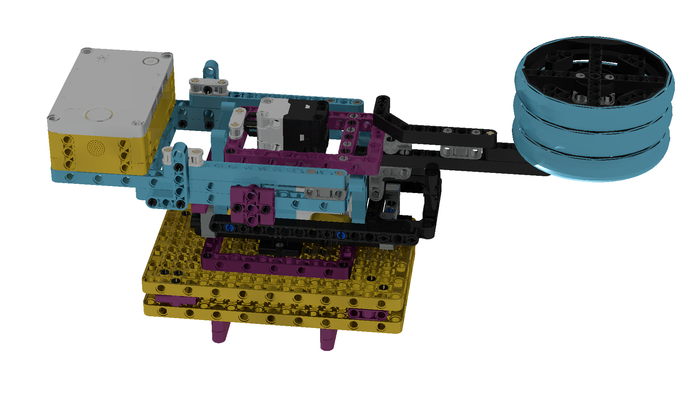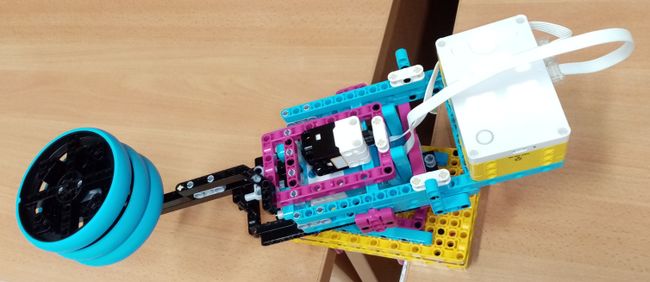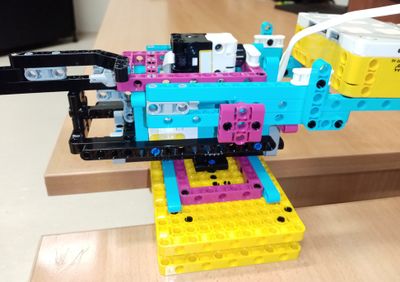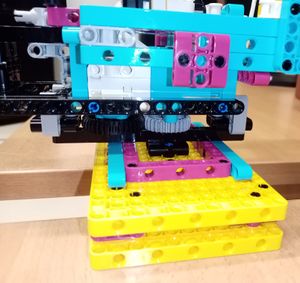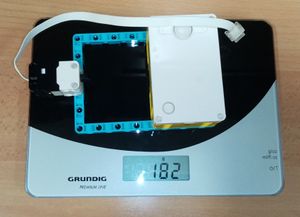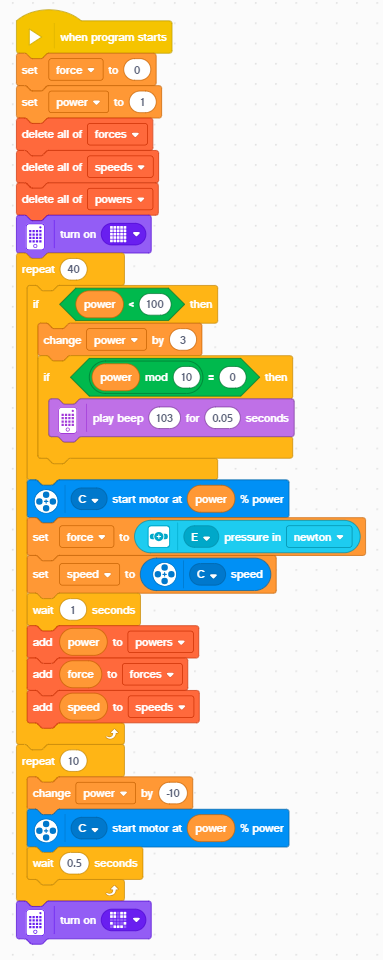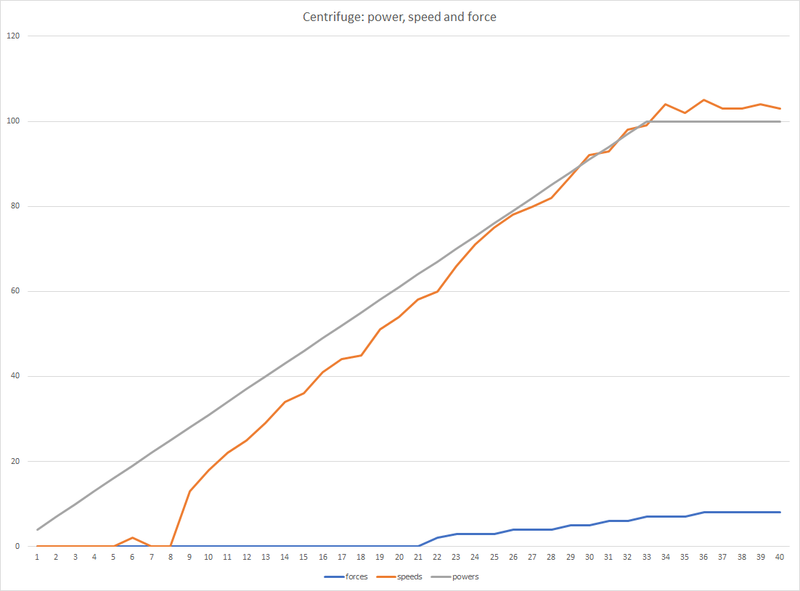Difference between revisions of "Spike Prime - Centrifugal Force"
(Created page with "== Let's begin == introduction... == Build == Model: model of centrifuge|700px Pictures: centrifuge|300px...") |
m |
||
| (5 intermediate revisions by the same user not shown) | |||
| Line 1: | Line 1: | ||
| + | <small>(''[[Spike up Prime Interest in Physics|back to list of projects]]'')</small> | ||
| + | |||
== Let's begin == | == Let's begin == | ||
| − | + | A moving body would like to continue in a straight motion. If it is bound to by a string, or some other way it will move along a circular trajectory but it will pull the string with a centrifugal force. How large is this force? We will measure it using the force sensor in this exercise. | |
== Build == | == Build == | ||
| Line 11: | Line 13: | ||
Pictures: | Pictures: | ||
| − | [[Image: | + | [[Image:spike_centrifuge_1.jpg|centrifuge|650px]] |
| + | [[Image:spike_centrifuge_2_detail.jpg|detail|400px]] | ||
| + | [[Image:spike_centrifuge_3_more_detail.jpg|more detail|300px]] | ||
| + | [[Image:spike_centrifuge_4_weight_of_free_parts.jpg|weight of free parts|300px]] | ||
Building instructions: | Building instructions: | ||
| Line 32: | Line 37: | ||
Download: [[Media:centrifuge.llsp|centrifuge.llsp]] | Download: [[Media:centrifuge.llsp|centrifuge.llsp]] | ||
| − | + | The program slowly accelerates the rotating movement by increasing the motor power from 1 to 100. While accelerating, it is recording the actual power, the resulting motor speed and the force applied to the force sensor. Use the dumpdata.zip program from the pendulum exercise to extract the data, show them in a table and a chart. Measure the rotating arm length and the weight of the mass that is pulling the sensor. | |
| − | |||
| Line 41: | Line 45: | ||
<youtube>G4ojUkdTsSc</youtube> | <youtube>G4ojUkdTsSc</youtube> | ||
| − | * | + | * Be careful when running the experiment, the rotating body accumulates a lot of energy! Use the bottom bricks to fix the model in between two tables. |
Example result of measurement: | Example result of measurement: | ||
| + | |||
| + | forces=0,0,0,0,0,0,0,0,0,0,0,0,0,0,0,0,0,0,0,0,0,2,3,3,3,4,4,4,5,5,6,6,7,7,7,8,8,8,8,8 | ||
| + | speeds=0,0,0,0,0,2,0,0,13,18,22,25,29,34,36,41,44,45,51,54,58,60,66,71,75,78,80,82,87,92,93,98,99,104,102,105,103,103,104,103 | ||
| + | powers=4,7,10,13,16,19,22,25,28,31,34,37,40,43,46,49,52,55,58,61,64,67,70,73,76,79,82,85,88,91,94,97,100,100,100,100,100,100,100,100 | ||
[[Image:spike_centrifuge_chart.png|centrifuge|800px]] | [[Image:spike_centrifuge_chart.png|centrifuge|800px]] | ||
| Line 52: | Line 60: | ||
== Explore and modify == | == Explore and modify == | ||
| − | * Modify the program so that .. | + | * Modify the program so that the speed will not only increase, but also decrease several times. Observe the time delay in the reaction of motor speed change following after the power changes. |
| − | * | + | * Repeat the same experiment with different weight. You can also try to change the gear ratio at the bottom of the model to obtain different speeds. |
== Present == | == Present == | ||
Latest revision as of 03:28, 7 March 2020
Let's begin
A moving body would like to continue in a straight motion. If it is bound to by a string, or some other way it will move along a circular trajectory but it will pull the string with a centrifugal force. How large is this force? We will measure it using the force sensor in this exercise.
Build
Model:
Pictures:
Building instructions:
Download building instructions:
Download stud.io model:
Program
Download: centrifuge.llsp
The program slowly accelerates the rotating movement by increasing the motor power from 1 to 100. While accelerating, it is recording the actual power, the resulting motor speed and the force applied to the force sensor. Use the dumpdata.zip program from the pendulum exercise to extract the data, show them in a table and a chart. Measure the rotating arm length and the weight of the mass that is pulling the sensor.
Measure, analyze, think
- Be careful when running the experiment, the rotating body accumulates a lot of energy! Use the bottom bricks to fix the model in between two tables.
Example result of measurement:
forces=0,0,0,0,0,0,0,0,0,0,0,0,0,0,0,0,0,0,0,0,0,2,3,3,3,4,4,4,5,5,6,6,7,7,7,8,8,8,8,8 speeds=0,0,0,0,0,2,0,0,13,18,22,25,29,34,36,41,44,45,51,54,58,60,66,71,75,78,80,82,87,92,93,98,99,104,102,105,103,103,104,103 powers=4,7,10,13,16,19,22,25,28,31,34,37,40,43,46,49,52,55,58,61,64,67,70,73,76,79,82,85,88,91,94,97,100,100,100,100,100,100,100,100
- Perform measurements with your model and discuss in your group what has happened.
Explore and modify
- Modify the program so that the speed will not only increase, but also decrease several times. Observe the time delay in the reaction of motor speed change following after the power changes.
- Repeat the same experiment with different weight. You can also try to change the gear ratio at the bottom of the model to obtain different speeds.
Present
- Prepare a short presentation for other groups. Tell others about how your measurement went, what issues did you have to solve. What do they mean and why did they happen?
Additional resources
- Download: Centrifuge - all media files
